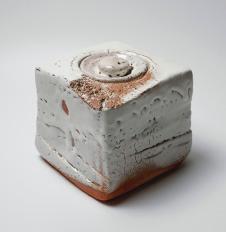
2 minute read
MIWA KYUSETSU XI 11 (1910-2012)
Haiku, Natsume Soseki
Miwa Kyusetsu XI (1910-2012) followed his older brother in becoming the Living National Treasure for the preservation of Hagi ware and was designated in 1983. Hagi ware is a high fired stoneware and is usually glazed with either a transparent glaze or a snow-white glaze that is made by adding rice straw ash to the clear glaze.
The origins of Hagi ware can be traced back to the late 16th century. The feudal lord of the Hagi region Terumoto Mori had appointed potters to create Hagi pottery for his personal tea ceremonies. Gradually, the taste for Hagi-yaki became more and more widespread, until the Meiji restoration in 1868, when it grew in popularity because potters could become independently employed. There are several types of Hagi ware, but the most famous is the white Hagi type developed by the Miwa. The Miwa family’s kiln was established in 1663, and has been operating ever since.
The Miwa family have been making tea ceramics since 1666, and it is beyond doubt that they have created the reputation of Hagi ware as the number two tea ceramic (after raku ware from Kyoto). Miwa Kyusetsu XI is the master of Hagi’s famous white glaze and the Mizusashi (water jar) in this exhibition is a superb example of his contribution to the family’s reputation as well as being an example of the long tradition of Hagi tea ceramics. The sensuality of the glaze invites both touch and taste.










